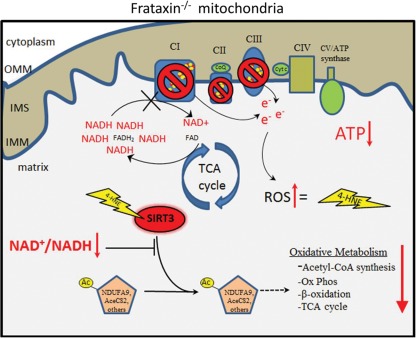Figure 5.
Cartoon schematic summarizing the mechanism of SIRT3 inhibition in frataxin-deficient cardiac mitochondria. Impaired ISC biosynthesis in frataxin−/− mitochondria results in defects of respiratory complexes I, II and III, which cause impaired oxidation and accumulation of NADH generated by the TCA cycle. The resulting dramatic decrease in the mitochondrial NAD+/NADH ratio (redox state) creates a reducing environment mimicking nutrient excess. In addition, an increased sensitivity to oxidative stress consequently promotes lipid peroxidation and the formation of 4-HNE protein carbonyl adducts. The dramatic decrease in mitochondrial redox state and increase in 4-HNE modified SIRT3 work in concert to inhibit SIRT3 activity, causing protein hyperacetylation and most likely reduced activity of SIRT3 target proteins which have been shown to play key roles in the maintenance of oxidative and intermediary metabolism. OMM, outer mitochondrial membrane; IMS, intermembrane space; IMM, inner mitochondrial membrane; ROS, reactive oxygen species; 4-HNE, 4-hydroxy-2-nonenal; NDUFA9, NADH dehydrogenase (ubiquinone) 1 alpha subcomplex subunit 9; AceCS2, acetyl-CoA synthetase 2.

